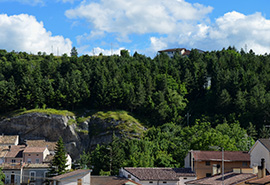The faunistic area for the Bear located at Colle Veduta inserts itself in the activities of the Majella National Park and is raising the profile for the protection of the brown bear and public awareness on the need to safeguard the species . Its purpose is exclusively for educational activities and environmental education. The area covers 10,770 square meters and is characterized by a forest of fir trees, shrubs, fruit trees, grazing areas.
In the territory of Palena this intervention complements the Museum of the brown bear, hosted at the convent of St. Anthony, which will be connected through a video surveillance system that, in addition to ensuring constant monitoring of the animals housed in the area and the flow of visitors, it allows you to observe the bears up close without disturbing them.
The center houses two female specimens of Ursus arctos arctos, born in captivity in the swiss park Juraparc (Vallorbe) and unable to return to the free life.
The territory of Palena is constantly visited by the brown bear, of smaller dimesions the native apennines subspecies. The citizens and tourists who visit and familiarization themselves with the bear and the wildlife area will also foster good living relations with the "free" bears of the Majella Park.
* Thank you dr.Simone Angelucci, veterinarian at the Majella National Park Authority for information on the area wildlife.

The faunistic area for the Bear located at Colle Veduta inserts itself in the activities of the Majella National Park and is raising the profile for the protection of the brown bear and public awareness on the need to safeguard the species . Its purpose is exclusively for educational activities and environmental education. The area covers 10,770 square meters and is characterized by a forest of fir trees, shrubs, fruit trees, grazing areas.
In the territory of Palena this intervention complements the Museum of the brown bear, hosted at the convent of St. Anthony, which will be connected through a video surveillance system that, in addition to ensuring constant monitoring of the animals housed in the area and the flow of visitors, it allows you to observe the bears up close without disturbing them.
The center houses two female specimens of Ursus arctos arctos, born in captivity in the swiss park Juraparc (Vallorbe) and unable to return to the free life.
The territory of Palena is constantly visited by the brown bear, of smaller dimesions the native apennines subspecies. The citizens and tourists who visit and familiarization themselves with the bear and the wildlife area will also foster good living relations with the "free" bears of the Majella Park.
* Thank you dr.Simone Angelucci, veterinarian at the Majella National Park Authority for information on the area wildlife.